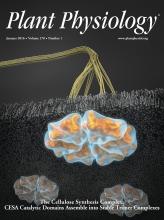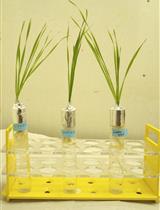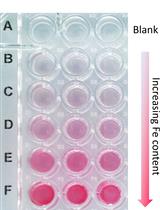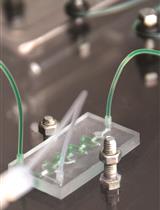- EN - English
- CN - 中文
Quantifying the Capacity of Phloem Loading in Leaf Disks with [14C]Sucrose
用[14C]蔗糖定量叶盘韧皮部装载能力
发布: 2017年12月20日第7卷第24期 DOI: 10.21769/BioProtoc.2658 浏览次数: 7353
评审: John F. C. SteeleAnonymous reviewer(s)
Abstract
Phloem loading and transport of photoassimilate from photoautotrophic source leaves to heterotrophic sink organs are essential physiological processes that help the disparate organs of a plant function as a single, unified organism. We present three protocols we routinely use in combination with each other to assess (1) the relative rates of sucrose (Suc) loading into the phloem vascular system of mature leaves (this protocol), (2) the relative rates of carbon loading and transport through the phloem (Yadav et al., 2017a), and (3) the relative rates of carbon unloading into heterotrophic sink organs, specifically roots, after long-distance transport (Yadav et al., 2017b). We propose that conducting all three protocols on experimental and control plants provides a reliable comparison of whole-plant carbon partitioning, and minimizes ambiguities associated with a single protocol conducted in isolation (Dasgupta et al., 2014; Khadilkar et al., 2016). In this protocol, Arabidopsis leaf disks isolated from mature rosette leaves are infiltrated with a buffered solution containing [14C]Suc. Suc transporters (SUCs or SUTs) load Suc into the phloem and excess, unloaded Suc in the leaf disk is then washed away. Loading of labeled Suc into the veins is visualized by autoradiography of lyophilized leaf disks and quantified by scintillation counting. Results are expressed as disintegration per minute per unit of leaf disk fresh weight or area.
Keywords: Arabidopsis (拟南芥)Background
Transport of photoassimilates from source to sink organs is essential for normal growth and maintenance of whole plants. Phloem loading in leaves is the delivery of photoassimilate synthesized in mesophyll cells to the companion cells (CC) and sieve elements (SE) of the phloem vasculature system. Three distinct loading mechanisms are recognized. Two of these expend energy to accumulate high concentrations of sugar in the CC and SEs and generate a high hydrostatic pressure in source-leaf phloem. The first is apoplastic phloem loading, in which Suc (and/or sugar alcohols in some species) is loaded across the plasma membrane from the cell wall space (i.e., the apoplast) into the CCs at the expense of the proton motive force (Giaquinta, 1983). The second is polymer trapping, in which Suc diffuses into the phloem through specialized plasmodesmata and is converted to oligosaccharides that are too large to diffuse back out (Turgeon, 1996). The third mechanism is passive loading, in which the highest solute concentrations are in the mesophyll cells and plasmodesmata provide an open path for passive movement into the CCs and SEs (Rennie and Turgeon, 2009).
Due to the central role of phloem loading and transport to plant physiology and productivity, it is desirable to have reliable methods to identify and quantify the contents of the phloem and the rates of transport. In addition, phloem loading and transport are targets for biotechnology and metabolic engineering to enhance productivity (Ainsworth and Bush, 2011; Cao et al., 2013; Dasgupta et al., 2014; Zhang et al., 2015; Yadav et al., 2015). Quantitatively assessing the rates and capacity of phloem loading and transport in natural and engineered systems is difficult for several reasons. As examples, CCs and SEs are imbedded in surrounding tissues and are very narrow relative to surrounding non-phloem cells; the phloem is under high pressure and seals rapidly when damaged; collected phloem sap is usually contaminated with the content of other cells; because transport is a dynamic process, estimates of phloem content do not indicate rates of transport (Turgeon and Wolf, 2009; Dinant and Kehr, 2013; Tetyuk et al., 2013). C isotope 11C, 13C and 14C, in CO2 or labeled sugars, have provided, and continue to provide, critical information on phloem loading mechanisms (Sovonick et al., 1974; Turgeon and Gowan, 1990; Turgeon and Medville, 1998), as well as quantitative information on the rates of loading and transport (Thorpe and Minchin, 1988; Karve et al., 2015; Dersch et al., 2016).
Arabidopsis loads Suc from the apoplast with the Suc transporter (SUT) encoded by AtSUC2 (Truernit and Sauer, 1995; Gottwald et al., 2000; Srivastava et al., 2008). AtSUC2 and other transporters have been assessed in Saccharomyces cerevisiae and Xenopus laevis oocytes as heterologous systems to establish Michaelis Menten kinetic parameters (reviewed in [Ayre, 2011]). While valuable for comparing the activities and affinities among transporters, these do not inform on the activity of the transporters in planta, or on the overall impact on plant growth and productivity. As an example of this, SUTs from Solanaceae species with roughly the same kinetic properties as AtSUC2 did not rescue an Arabidopsis Atsuc2 mutant, while an AtSUC2 cDNA and ZmSUT1 cDNA from Zea mays did rescue the mutant (Dasgupta et al., 2014). In this protocol, and two that follow (Yadav et al., 2017a and 2017b), we detail the use of [14C]CO2 and [14C]Suc to quantitatively assess phloem loading and carbon transport in living explants and intact plants. These methods are used routinely in our laboratory, and recently contributed to our demonstration that plants over expressing certain SUTs in CCs showed increased phloem loading and transport, despite having stunted growth (Dasgupta et al., 2014) and, in a separate study, over expression of a H+-pumping pyrophosphatase enhanced Suc loading and transport without a corresponding increase in SUT expression levels (Khadilkar et al., 2016).
In the procedure described here (Figure 1), Arabidopsis leaf disks isolated from mature rosette leaves are vacuum infiltrated with a buffered solution containing [14C]Suc. SUTs load the Suc into CCs, and excess Suc is washed away. The disks are quickly frozen in powdered dry ice, lyophilized, and autoradiography is used to visualize loading into the veins. Rapid freezing and lyophilization prevent the highly soluble labeled sugar from diffusing away from the sites of loading. Scintillation counting then quantifies the loaded label. We generally pool four leaf disks into one replicate, and perform 6 biological replicates for each control and experimental system. This protocol was adapted for Arabidopsis (Dasgupta et al., 2014; Khadilkar et al., 2016) from procedures described by Turgeon and colleagues (Turgeon and Wimmers, 1988; Turgeon and Gowan, 1992; Turgeon and Medville, 1998; Haritatos et al., 2000; Goggin et al., 2001), and can be further adapted for other plants. Typical autoradiography results for Arabidopsis, tobacco, and wheat are shown in Figure 2; representative quantitative results of loading in different transgenic Arabidopsis plants are published (Dasgupta et al., 2014; Khadilkar et al., 2016).
Materials and Reagents
- Potting containers (The HC Companies, catalog number: IJT06060 ;Jumbo Insert)
- Potting mixture (Sun Gro Horticulture, catalog number: Fafard 3B Mix ; or similar)
- 24-well culture plates (Greiner Bio-One International, catalog number: 662160 )
- 5 ml transport vials (Stockwell Scientific, catalog number: 3205 )
- Nylon window screen (available at most hardware stores)
- Cyanoacrylate (Super Glue, or equivalent)
- Razor blades (Double-edged PERSONNA) (Electron Microscopy Sciences, catalog number: 72000 )
- Petri dishes (100 x 25 mm) (Fisher Scientific, catalog number: FB0875711 )
- Filter paper (Fisher Scientific, catalog number: 09-795C )
- Glass beads 4 mm (Water Stern, catalog number: 100E )
- Dow Corning high vacuum grease
- Thick, smooth paper (e.g., Bristol board or manila folder)
- Scintillation vials (Fisher Scientific, catalog number: 12383317 )
- Wax paper (Reynolds CUT-RITE)
- Aluminum foil envelopes (70 x 70 mm–homemade from standard aluminum foil)
- Autoradiography film (Kodak BioMax MR Film, Eastman Kodak, catalog number: 870 1302 )
- Plant material (e.g., Arabidopsis thaliana Col-0, control and experimental material), 10 to 12 healthy plants for each treatment
- Developer and fixer solutions (Eastman Kodak, catalog numbers: 190 0984 and 190 2485 )
- Sodium hypochlorite (NaClO) (Commercial bleach)
- Ecolume scintillation fluid (MP Biomedicals, catalog number: 0188247004 )
- 95% ethanol (Pharmco-AAPER, catalog number: 111000200 )
- 2(N-morpholino) ethane-sulfonic acid [MES] (Fisher Scientific, catalog number: BP300-100 )
- Calcium chloride dihydrate (CaCl2·2H2O) (Sigma-Aldrich, catalog number: 223506 )
- Potassium hydroxide (KOH) (Merck, catalog number: PX1480-1 )
- Sucrose (Fisher Scientific, catalog number: BP220-212 )
- [14C]Sucrose (100 µCi ml-1, > 350 mCi mmol-1) (MP Biomedicals, catalog number: 011113791 )
- Powdered dry ice (preferred) or liquid nitrogen
- Drierite desiccant (W A Hammond Drierite, catalog number: 13001 )
- MES/CaCl2 buffer (see Recipes)
- 1 mM Suc in MES/CaCl2 buffer (see Recipes)
- [14C]Suc in 1 mM Suc and MES/CaCl2 buffer (see Recipes)
Equipment
- Personal safety equipment: lab coat, nitrile gloves (or similar), and eye protection
- Growth chamber for Arabidopsis, 12 h light/12 h dark at ~100 µmol photons m-2 sec-1
- Cork borer (Carolina Biology, catalog number: 712202 )
- Cover glass forceps or similar (Fine Science Tools, catalog number: 11073-10 )
- Fine scissors (Fisher Scientific, catalog number: 08-951-20 )
- Vacuum bell jar (Kimble, catalog number: 31200-150 )
- Vacuum pump (Franklin Electric, catalog number: 1112585400 )
- Rotary shaker (Orbital Shaker Variable) (BioExpress, GeneMate, catalog number: S-3200-LS )
- Balance (METTLER TOLEDO, model: AE100 )
- Geiger counter (Ludlum Measurements, model: Model 3 )
- Lyophilizer (The VIRTIS company, catalog number: 10-030 )
- Mesh basket for lyophilizer chamber (homemade from metal window screen)
- Heavy duty bench vise (Kobalt 4” Vise)
- Two flat-surface, metal plates (~15 x 3 cm)
- Autoradiography cassettes (Exposure Cassette Kodak®) (Sigma-Aldrich, catalog number: E9010 )
- Autoradiography developing trays (Commercial plastic trays ~35 x 25 x 8 cm)
- Scintillation counter (Beckman Counter, model: LS 6000IC )
Procedure
文章信息
版权信息
© 2017 The Authors; exclusive licensee Bio-protocol LLC.
如何引用
Readers should cite both the Bio-protocol article and the original research article where this protocol was used:
- Yadav, U. P., Khadilkar, A. S., Shaikh, M. A., Turgeon, R. and Ayre, B. G. (2017). Quantifying the Capacity of Phloem Loading in Leaf Disks with [14C]Sucrose. Bio-protocol 7(24): e2658. DOI: 10.21769/BioProtoc.2658.
- Khadilkar, A. S., Yadav, U. P., Salazar, C., Shulaev, V., Paez-Valencia, J., Pizzio, G. A., Gaxiola, R. A. and Ayre, B. G. (2016). Constitutive and companion cell-specific overexpression of AVP1, encoding a proton-pumping pyrophosphatase, enhances biomass accumulation, phloem loading, and long-distance transport. Plant Physiol 170(1): 401-414.
分类
植物科学 > 植物生理学 > 营养
植物科学 > 植物生理学 > 光合作用
您对这篇实验方法有问题吗?
在此处发布您的问题,我们将邀请本文作者来回答。同时,我们会将您的问题发布到Bio-protocol Exchange,以便寻求社区成员的帮助。
提问指南
+ 问题描述
写下详细的问题描述,包括所有有助于他人回答您问题的信息(例如实验过程、条件和相关图像等)。
Share
Bluesky
X
Copy link












